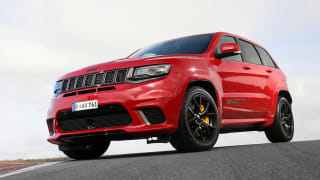
Jeep Grand Cherokee Trackhawk 2018 review
Of course it comes from America. A five-seat, family sized SUV powered by a 700hp supercharged V8 capable of out-accelerating exotic sports cars, and probably beating their lap times at the track.
Browse over 9,000 car reviews
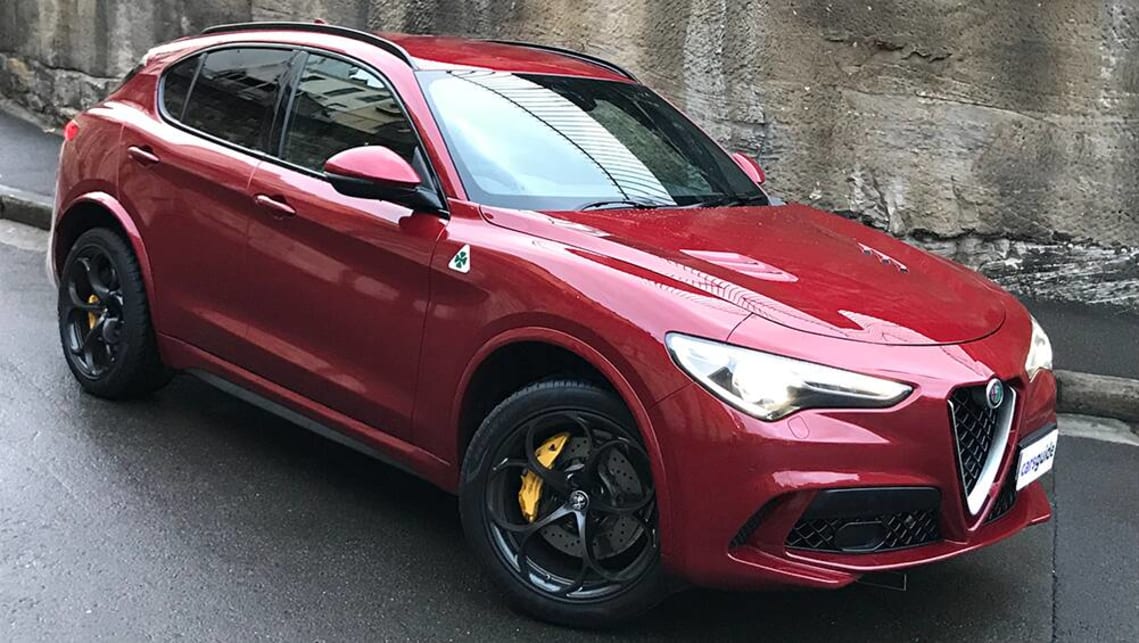
Alfa Romeo is as Italian as Michelangelo’s David, but it’s owned by Fiat Chrysler Automobiles, which puts heartland US brands like Dodge and Jeep under the same corporate umbrella.
So, it’s not a huge surprise if you’re experiencing automotive déjà vu when looking at the Alfa Stelvio Quadrifoglio.
Just as Jeep took the Dodge Challenger SRT Hellcat’s mega Hemi V8 and shoved it in the nose of its Grand Cherokee to create the unhinged Trackhawk, Alfa has pulled off a similarly audacious car-to-SUV transplant.
Granted, the outright power figures aren’t in the same stratospheric realm, but the intent is the same.
Take the thumping 2.9-litre twin-turbo V6 from the muscular and indecently rapid Giulia Quadrifoglio sedan, and drop it into the high-riding, five-seat Stelvio to create a Quadrifoglio version capable of accelerating from 0-100km/h in less than four seconds.
Does Alfa’s take on the family-fast formula allow enthusiast drivers to have their practicality cake and eat it with a side order of dynamic performance? We got behind the wheel to find out.
| Alfa Romeo Stelvio 2019: Quadrifoglio | |
|---|---|
| Safety rating | |
| Engine Type | 2.9L turbo |
| Fuel Type | Premium Unleaded Petrol |
| Fuel Efficiency | 10.2L/100km |
| Seating | 5 seats |
| Price from | $95,920 |
Alessandro Maccolini has been a constant in the Alfa Romeo Style Centre for 25 years. As head of exterior design he’s guided the brand’s increasingly sophisticated look, through to the most recent Giulia and Stelvio, with the beautiful Tonale compact SUV concept and soon-to-arrive GTV coupe pushing the boat out even further.
Resplendent in rich ‘Competizione Red’ our Stelvio Quadrifoglio bears a strong resemblance to its Giulia stablemate (they’re underpinned by the same ‘Giorgio’ platform), its fierce expression constructed around the signature ‘tri bolo’ shield grille which is able to descend all the way down the nose courtesy of an offset front licence plate.
Long, angular (adaptive bi-xenon) headlights wrap around each front corner, while a broad two-level splitter with black mesh air intakes above adds a racy aero touch. Dual bonnet vents add another hint of performance purpose.
A subtle combination of gentle curves and harder character lines down the car’s flanks merge with aggressively pumped guards filled by 20-inch five-ring forged alloy rims.
With the turret sloping sharply towards the rear, the Stelvio has the look of an SUV ‘coupe’ in similar fashion to the BMW X4 and Merc GLC Coupe. And gloss black side window surrounds and roof rails are a no-nonsense touch, while Alfa spotters will like the iconic Quadrifoglio (four-leaf clover) badges at the top of the front guards.
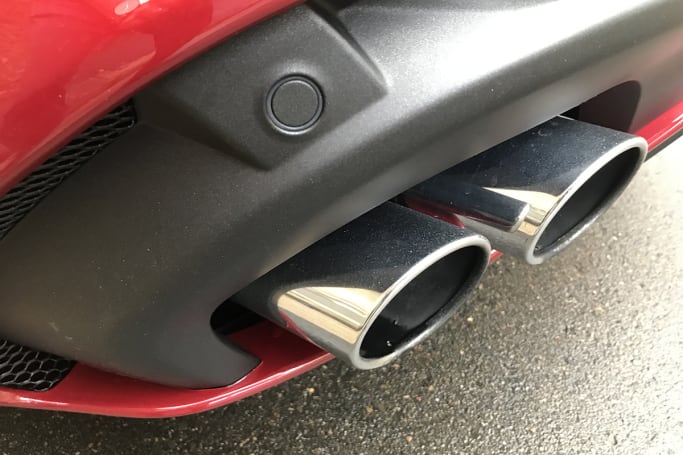
The LED tail-lights echo the general shape of the headlights, with clearly defined horizontal sections stacking together to create a relatively upright rear end. Quad exhaust pipes and a five-channel (functional) diffuser enhance the car’s macho personality.
The interior is as brilliant to look at as it is to occupy. A mix of leather, Alcantara, brushed alloy and carbon-fibre adorns a cool and sophisticated design incorporating echoes of Alfas past and the latest tech the brand has to offer.

Our car featured an especially carbon-rich environment thanks to optional Sparco carbon-fibre front seats ($7150) and a leather, Alcantara and carbon sports steering wheel ($4550).
A dual cowl instrument cluster, complete with accentuated eyebrows in the dashtop above each gauge is an Alfa hallmark, as are eyeball air vents at either end of the dash fascia.
An 8.8-inch colour multimedia screen is seamlessly integrated at the top of the centre stack and contrast red stitching across the seats, doors and dash, as well as the restrained use of genuine, top-shelf materials highlights the interior’s quality and attention to design detail.
Eight colours are offered, including the single no-cost shade of (solid) ‘Alfa Red’. There are five optional metallic shades – ‘Vulcano Black’, ‘Silverstone Grey’, ‘Vesuvio Grey’, ‘Montecarlo Blue’, and ‘Misano Blue’ (+$1690), with two ‘Tri-Coat’ finishes (different base and main coat colours with clear over), ‘Competizione Red’ and ‘Trofeo White’ ($4550).
Despite the fire and brimstone lurking under its bonnet, the Stelvio Quadrifoglio must still function as a premium five-seat SUV. And at 4.7m long, 1.95m wide and just under 1.7m tall, its external dimensions align almost exactly with the Alfa’s key premium mid-size category competitors like Audi’s Q5, the BMW X3, Jaguar F-Pace, Lexus RX and Merc GLC.
The Stelvio Quadrifoglio’s price, spec and performance realign that competitive set somewhat, but we’ll get to that in the (next) value-for-money segment.
No problem with head and shoulder room for the driver and front seat passenger, although clearing the pronounced side bolsters on the front seat cushions takes some effort on the way in and out. Stand by for premature wear on the outer trim.
Storage runs to two cupholders (under a sliding carbon cover) in the centre console, as well as decent bins and bottle holders in the doors.
There’s also a medium-size glove box, plus a lidded, illuminated bin between the front seats, housing a pair of USB ports and an ‘aux-in’ jack. A third USB socket and a 12-volt outlet are snuck into the lower section of the dash.
Sitting behind the driver’s seat set for my 183cm frame, I had plenty of rear legroom, although headroom is best described as adequate.
Three sizeable adults across the rear will need to be good friends and the short straw holder in the centre will not only cop a harder and smaller seat, but struggle for foot space thanks to a broad and fairly high central tunnel.
On the plus side, the doors open wide for relatively easy access, there are two cup/bottle holders in the fold-down centre armrest, and small bins in the doors with a cut-out to retain modest bottles.
There are also adjustable air vents in the back of the front centre console, with a pair of USB charge outlets and a small storage hidey-hole underneath. But forget map pockets in the front seat backs, in our car it was a case of professional-grade carbon-fibre as far as the eye could see.
With the 40/20/40 split-folding rear seatbacks upright, Alfa claims 525 litres of boot space, which is fair for the class, and more than enough to swallow our three-piece hard suitcase set (35, 68 and 105 litres) or the CarsGuide pram, with room to spare.
A rail system recessed into either side of the floor allows infinite adjustment of a quartet of flip-up cargo anchor points, and an elastic storage net is included. Nice.
The boot door can be opened and closed remotely, which is always a welcome feature. Release handles near the rear door opening drop the back seats with a simple flick, there are handy shopping bag hooks either side of the boot, plus a 12-volt outlet and useful illumination. A small storage tray behind the driver’s side wheel tub is a thoughtful inclusion, with the same spot on the opposite side chock full of sub-woofer.
Don’t bother looking for a spare of any description, a repair/inflator kit is your only option (although you get a pair of gloves, which is civilised), and be aware the Stelvio Quadrifoglio is a no-tow zone.
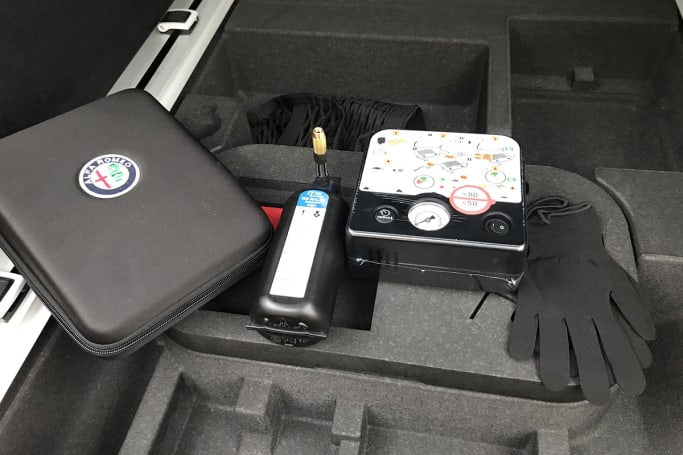
At $149,900 before on-road costs, the addition of the Quadrifoglio tag lifts this Alfa Stelvio out of the mid-size premium SUV segment into an altogether more exclusive, exciting and expensive competitive set.
Family practicality combined with ludicrously high-performance also describes the Jaguar F-Pace SVR V8 ($139,648) and Merc-AMG GLC 63 S ($165,395), while for $134,900 the Jeep Grand Cherokee Trackhawk slams 522kW (700hp) and 868Nm on the table.
That’s right, Jeep’s all-wheel drive monster, claimed to be the fastest petrol-powered SUV on the planet (0-100km/h in 3.7 seconds) is yours for $15k less than this Italian bad boy.
But, while you might give away a tenth of a second in the sprint to triple figures you pick up an immense amount of standard equipment in return.
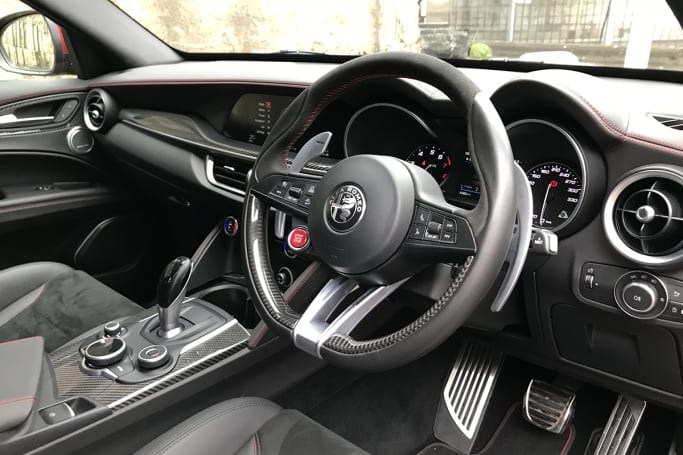
We’ll cover safety and performance tech (of which there’s plenty) in later sections, but the run-down of other included features extends to premium leather and Alcantara upholstered seats, Quadrifoglio leather steering wheel (with red starter button), leather upholstered dashboard, upper door and central armrest, carbon-fibre interior trim (lots of it), dual-zone climate control (with adjustable vents in the rear), and eight-way electrically-adjustable front seats (with four-way lumbar adjust and power bolster for the driver).
The front seats and steering wheel are heated, and you can also expect keyless entry (including passenger side) and start, auto adaptive headlights (with auto high beam), rain-sensing wipers, privacy glass on the side rear windows (and rear screen), as well as 14-speaker, 900-watt Harman Kardon ‘Sound Theatre’ audio (with Apple CarPlay/Android Auto compatibility and digital radio) managed through an 8.8-inch multimedia screen with 3D navigation.
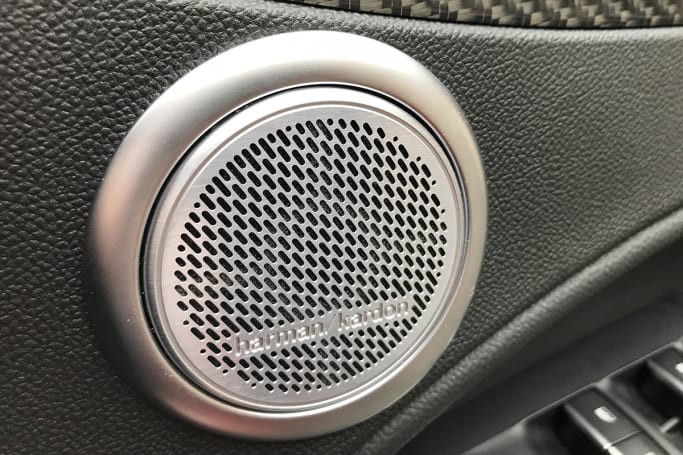
Worth noting that main media interface isn’t a touchscreen, a rotary dial on the console your only means of moving through modes and functions.
There’s also a 7.0-inch multi-function TFT read-out in the centre of the instrument cluster, ambient interior lighting, aluminium-faced pedals, Quadrifoglio door sill scuff plates (with aluminium insert), exterior door handle courtesy lights, power folding exterior mirrors, headlight washers (with heated nozzles), the 20-inch forged alloy wheels, and red brake calipers.
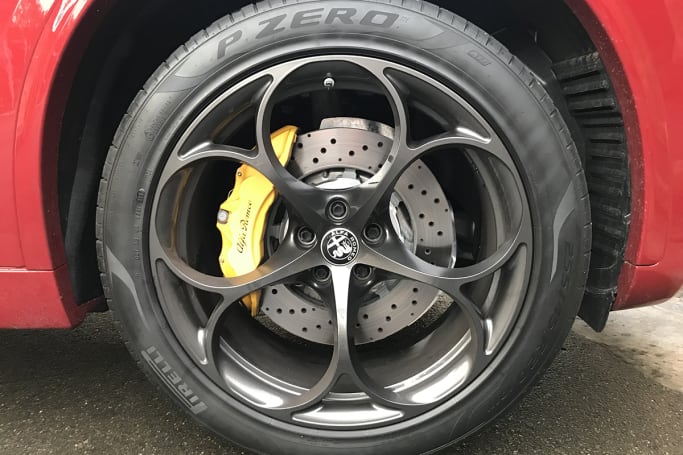
Phew! Even in the mid-$150k bracket that’s a monumental load of fruit, and a big contributor to the Stelvio Quadrifoglio’s solid value-for-money credentials.
For the record, our test car also featured Sparco carbon-fibre trim seats ($7150), yellow brake calipers in place of the standard red items ($910), Tri-Coat paint ($4550), and a leather, Alcantara and carbon-wrapped steering wheel ($650), for an as-tested price of $163,160.
Developed with input from Ferrari, the Stelvio Quadrifoglio’s 2.9-litre, twin-turbo, direct-injected petrol V6 is an all-alloy, 90-degree unit producing 375kW (510hp) at 6500rpm, and 600Nm from 2500-5000rpm.
It sends drive through an eight-speed automatic transmission to all four wheels via Alfa’s ‘Q4’ all-wheel drive system. Default torque distribution is 100 per cent to the rear, with the Q4 system’s active transfer case able to shift 50 per cent to the front axle.
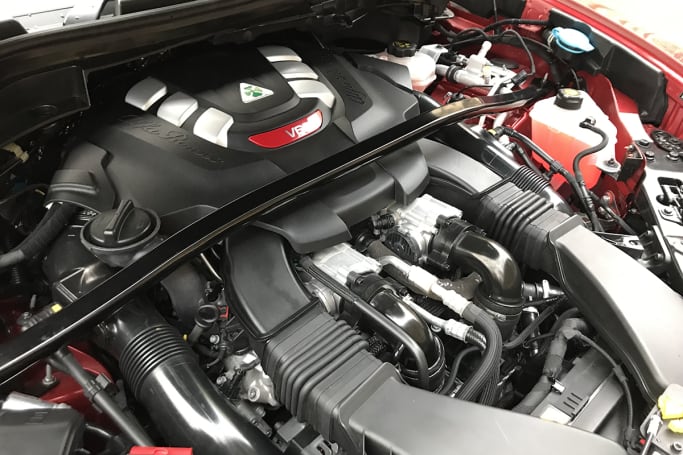
Alfa claims the transfer case’s active clutch delivers high response speed and precise torque distribution, taking input from a range of sensors measuring lateral and longitudinal acceleration, steering wheel angle and yaw rate.
From there, active torque vectoring uses two electronically-controlled clutches in the rear diff to feed drive the back wheel that can best use it.
Claimed fuel economy for the combined (ADR 81/02 - urban, extra-urban) cycle 10.2 L/100km, the twin-turbo V6 emitting 233g/km of CO2 in the process.
Despite standard start/stop and ‘CEM’ cylinder deactivation (dropping three cylinders where appropriate) complete with ‘sailing’ function (in Advanced Efficiency mode), over close to 200km of city, suburban and freeway running we recorded an average of 17.1L/100km, with the instant economy dash read-out leaping into scary territory when the car’s performance potential was explored.
Minimum fuel requirement is 98 RON premium unleaded and you’ll need 64 litres of it to fill the tank.
Do you want the good news, or the bad news? Okay, the good news is the Stelvio Quadrifoglio is properly fast, incredibly responsive and communicative in quick cornering, and ergonomically outstanding.
The bad news is it sounds like a diesel, the powertrain and suspension lack refinement at urban speeds, and although powerful, the brake system’s initial bite is as subtle as a Great White with blood in its nostrils.
Zero-100km/h acceleration in 3.8sec is exotic sports car territory and quick enough to elicit the prerequisite number of gasps and squeals from startled occupants.
With eight ratios and 600Nm to play with it’s easy to keep the Stelvio Q on the boil, with maximum torque available from 2500rpm all the way to 5000rpm.
But squeeze the throttle from low revs and you’ll be waiting a couple of beats for the turbos to do their best work. Where Merc-AMG has tinkered with turbo location and inlet/exhaust manifold lengths to minimise lag, this engine delivers its substantial thrust in a relative rush.
At the same time, the dual-mode quad exhaust system builds on the engine’s gruff note, but this car lacks the characteristic throbbing beat of its V8 rivals. A coarser, less syncopated sound emerges from the engine bay and quad exhaust tips.
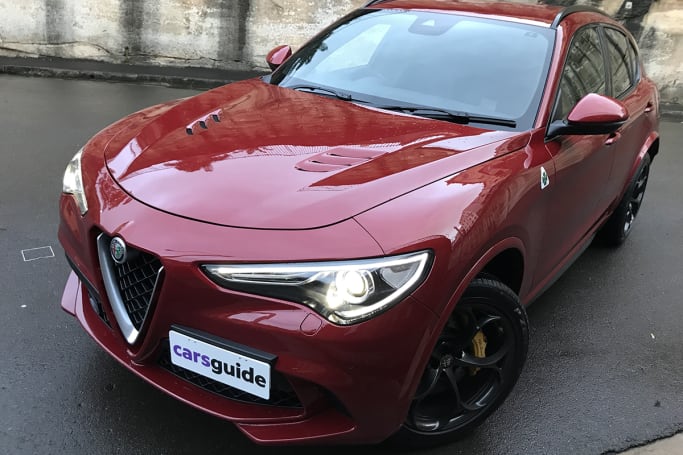
But shift the drive mode selector to D (for Dynamic), head to your favourite backroad, and the Stelvio carves corners more effectively than any high-riding SUV has a right to.
In the Stelvio (and Giulia) Quadrifoglio Alfa’s ‘DNA’ system (Dynamic, Natural, Advanced efficiency) is supplemented with a Race mode, which allows deactivation of the stability and traction controls and dials up the exhaust note. It’s designed for the race circuit, and we didn’t engage it (except to check the exhaust note change).
However, the Dynamic setting modifies engine control parameters for faster power delivery, increases gearshift speed and tweaks the active suspension for a more urgent dynamic response. Manual changes, using the elegant alloy shift paddles, are satisfyingly quick.
Response from the electrically-assisted variable ratio steering is brilliantly linear and accurate, with excellent road feel thrown in for good measure. Plus, the combination of a great seat, grippy wheel, perfectly located controls and clear read-outs means you can get on with the job of enjoying the drive without stress.
Suspension is double wishbone front / multi-link rear and despite a hefty 1830kg kerb weight the Stelvio Quadrifoglio remains balanced and predictable, with body control well buttoned-down.
The active all-wheel drive and torque vectoring systems work seamlessly to keep things headed in the right direction, grip from the high-performance Pirelli P Zero rubber (255/45 fr - 285/40 rr) is tenacious and power is put to the ground with complete authority.
Braking is by Brembo ventilated and cross-drilled rotors (360mm fr - 350mm rr) with six-piston front and four-piston rear calipers. Alfa actually calls it the ‘Monster Brake System’ and stopping power is immense. But slow to a suburban pace and several shortcomings emerge.
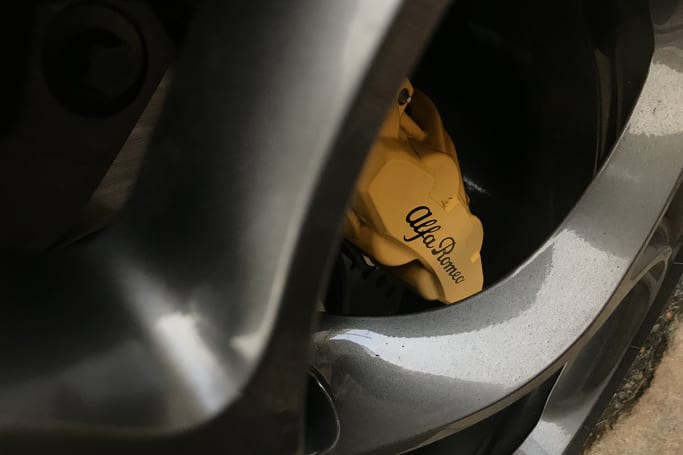
First, the braking hardware is backed up by an electromechanical brake-by-wire system, which Alfa says is lighter, more compact and faster than a conventional set-up. That may be, but initial application is met with an abrupt, jolting grab that’s hard to avoid and very tedious.
Even from a gentle step-off, the driveline feels shunty with minor shudders also emerging in the switch from forward to reverse ratios in tight turning and parking manoeuvres.
Then there’s the ride. Even in its most pliable setting, the suspension is firm, with every bump, crack and pothole announcing its presence through the body and seat of your pants.
There’s so much to like about the way this car drives, but these loose ends make you think it needed another six to nine months in engineering development and testing to smooth the balance between five tenths and 10 tenths driving.
Basic Warranty
3 years / 150,000 km warranty
ANCAP Safety Rating

The Stelvio Quadrifoglio boasts an impressive array of standard active safety tech including, ABS, EBD, ESC, EBA, traction control, forward collision warning with all-speed AEB, lane departure warning, blind spot monitoring with rear cross path detection, active cruise control, active high beam headlights, reversing camera (with dynamic grid lines), front and rear parking sensors, emergency stop signal, and a tyre pressure monitoring system.
If an impact is unavoidable there are six airbags on-board (dual front, dual front-side and dual curtain).
The Stelvio received a maximum five-star ANCAP rating when it was assessed in 2017.
Alfa’s standard warranty is three years/150,000km with 24-hour roadside assistance provided for the same period. That’s well off the mainstream pace, with virtually all volume brands at five years/unlimited km, and some at seven years/unlimited km.
Recommended service interval is 12 months/15,000km (whichever comes first), and Alfa’s capped price servicing scheme locks in prices for the first five services as: $894, $1346, $894, $2627, and $883; an average of $1329, and a five-year total of $6644. So, you’re paying the price for a pedigreed engine and drivetrain.
Fast but flawed, the Alfa Romeo Stelvio Quadrifoglio is a sleek and sophisticated high-performance SUV that’s well equipped and dynamically outstanding. But for the time being driveline refinement, brake tuning and ride comfort sit in the could do better column.
| Vehicle | Specs | Price* | |
|---|---|---|---|
| (base) | 2.0L, PULP, 8 SP AUTO | $47,850 – 55,000 | 2019 Alfa Romeo Stelvio 2019 (base) Pricing and Specs |
| TI | 2.0L, PULP, 8 SP AUTO | $55,000 – 63,250 | 2019 Alfa Romeo Stelvio 2019 TI Pricing and Specs |
| Quadrifoglio | 2.9L, PULP, 8 SP AUTO | $95,920 – 110,220 | 2019 Alfa Romeo Stelvio 2019 Quadrifoglio Pricing and Specs |
| Quadrifoglio Nring LTD Edition | 2.9L, PULP, 8 SP AUTO | $143,220 – 164,670 | 2019 Alfa Romeo Stelvio 2019 Quadrifoglio Nring LTD Edition Pricing and Specs |
| Design | 9 |
|---|---|
| Practicality | 8 |
| Price and features | 8 |
| Under the bonnet | 8 |
| Efficiency | 7 |
| Driving | 7 |
| Safety | 8 |
| Ownership | 6 |
$33,990
Lowest price, based on 6 car listings in the last 6 months